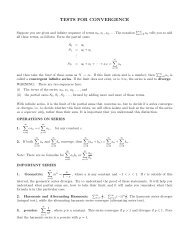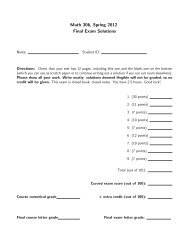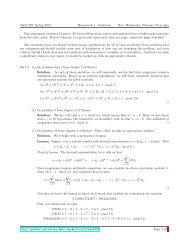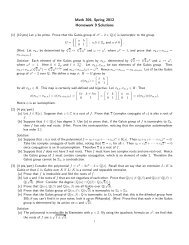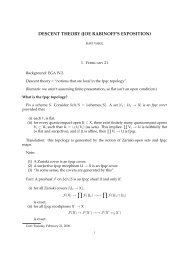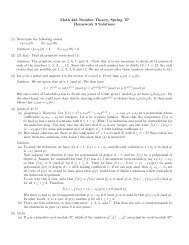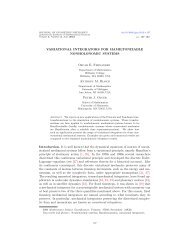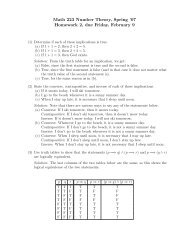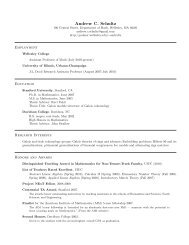MATH 52: MATLAB HOMEWORK 1 1. Approximating functions A ...
MATH 52: MATLAB HOMEWORK 1 1. Approximating functions A ...
MATH 52: MATLAB HOMEWORK 1 1. Approximating functions A ...
Create successful ePaper yourself
Turn your PDF publications into a flip-book with our unique Google optimized e-Paper software.
<strong>MATH</strong> <strong>52</strong>: <strong>MATLAB</strong> <strong>HOMEWORK</strong> 1<strong>1.</strong> <strong>Approximating</strong> <strong>functions</strong>A typical method for understanding complicated mathematical objects is to attempt to approxmate them aslimits of relatively simple objects. The prototypical example is to approximate an arbitrary function f : R → Ras a linear combination of the monomials 1, x, x 2 , · · · . In this case the nth order approximation of f(x) is of theformn∑c 0 + c 1 x + c 2 x 2 + · · · + c n x n = c j x jwhere c j are real numbers that depend on the function f. Unless f is a polynomial, there is no n so that the nthorder approximation of f(x) is identically f(x), so instead we hope that the limit of nth order approximationsconverge to f(x). Expressed as an equation our hope isn∑f(x) = lim c j x j .n→∞j=0There is a great deal which needs to be made precise in a statement such as this; for example, what does thislimit mean, for what values of x can we expect this equality to hold. For now we content ourselves with askinghow to find the coefficients c j in a systematic way. Provided f(x) has the appropriate derivatives, one answerto this question is given by the theory of Taylor series. For points x which are ‘sufficiently close to’ 0, we havef(x) = f(0) + f ′ (0)x + f ′′ (x)x 2 + · · · + f n (0)x n + · · · .2n!Notice that to find the coefficients c j we need to know information about the derivatives of f(x) at x = 0.Example.Let f(x) = e x , and recall that f (n) (x) = e x for all n. Hence f (n) (0) = 1 for any n, and so the Taylor series ofe x beginse x = 1 + 1 2 x2 + 1 6 x3 + 1 24 x4 + 1120 x5 + · · · .MatLab also has a built in feature for computing the Taylor series of a function: taylor. For instance, if wewanted the first 10 terms of the Taylor Series for e x instead of the first 6 (which we just listed), we use thefollowing MatLab command.>> syms x>> taylor('exp(x)',x,10)j=0The function taylor has three arguments: the first is the function (notice it’s within single quotes), thesecond is the variable, and the third is the number of terms in the series you would like. Notice also that wehad to begin by declaring x as a variable using the syms command. If you don’t do this, MatLab will have a fit!Exercise. Compute the first seven terms of the Taylor series for f(x) = − log(1 − x). Compute the first seventerms of the Taylor series for g(x) = e x /cos(x) + tan 3 (x).
2 <strong>MATH</strong> <strong>52</strong>: <strong>MATLAB</strong> <strong>HOMEWORK</strong> 12. <strong>Approximating</strong> periodic <strong>functions</strong>: Fourier seriesWhile the monomials {x j } are a useful collection of “basic <strong>functions</strong>” for approximating arbitrary <strong>functions</strong>,in certain contexts it can be useful to choose a different collection of “basic <strong>functions</strong>.” For instance, if you wishto study all <strong>functions</strong> f : R → R which satisfy f(x) = f(x + 2π) (i.e., <strong>functions</strong> which are periodic with perioddividing 2π), it is typical to use the <strong>functions</strong>· · · , e −3ix , e −2ix , e −ix , 1, e ix , e 2ix , e 3ix , · · · .Here i is the complex number √ −<strong>1.</strong> Though it might seem bizarre to use complex <strong>functions</strong> to approximate<strong>functions</strong> f : R → R, it is an old but important result of that these <strong>functions</strong> are “enough” to express all suchperiodic <strong>functions</strong>, in the sense that for any function f(x) satisfying f(x) = f(x + 2π) there are real numbers· · · , a −3 , a −2 , a −1 , a 0 , a 1 , a 2 , a 3 , · · · so that⎡ ⎤n∑f(x) = lim ⎣ a j e ijx ⎦ .n→∞This is called the Fourier series expansion of f(x). If you like, you can think of ∑ nj=−n a je ijx as the nth orderapproximation of f(x). The coefficients {a i } are called the complex Fourier coefficients of the function f(x).Example.j=−nThe function( ⌊( )⌋)x + π x + πf(x) = 22π− − 12πis shown in blue in Figure <strong>1.</strong> On the same axes we show the first, second, third, fourth and fifth orderapproximations of f(x) (colored green, red, teal, purple, and yellow, respectively) using the complex Fouriercoefficientsa 0 = 0, a ±1 = − i π , a ±2 =i2π , a ±3 = − i3π , a ±4 =i4π , and a ±5 = − i5π .10.50−0.5−1−3 pi −2 pi −pi 0 pi 2 pi 3 piFigure <strong>1.</strong> The function f(x) and the Fourier approximationsAs with Taylor series there are natural questions to ask about the Fourier series of a function f(x), andagain we will limit our discussion to how one computes the corresponding complex Fourier coefficients. Happily,just as with Taylor series, the theory of Fourier series comes equipped with an easy method for computing
<strong>MATH</strong> <strong>52</strong>: <strong>MATLAB</strong> <strong>HOMEWORK</strong> 1 3these coefficients; but while Taylor series use derivatives, one uses integrals to compute Fourier coefficients.Specifically,a j = 1 ∫ πf(x)e −jix dx.2π −πExample.Notice that in the example above, the function f(x) is equivalent to g(x) = x πon the interval [−π, π]. To findthe complex Fourier coefficient a 1 for f(x), one may run int function on MatLab.>> clear x; syms x;>> int((x/pi)*exp(-i*x),x,-pi,pi)/(2*pi)ans =-i*piThe int command on MatLab takes four arguments: the first is the function to be integrated, the second thevariable of integration, the third the left hand endpoint of the interval of integration, and the final argument isthe right hand endpoint of the interval of integration.Notice that this answer is the coefficient that we used in the previous example. To find the remaining coefficients,one can compute similar integrals to the one above. For instance, to find the coefficient a −2 one computes>> clear x; syms x;>> int((x/pi)*exp(-i*-2*x),x,-pi,pi)/(2*pi)The previous example illustrates an important idea in the application of Fourier series: one only needs toknow the behavior of a function on the interval [−π, π] in order to computer Fourier coefficients. Indeed thisidea can be used to give a Fourier decomposition of a function on the domain [−π, π]–even if the function is notperiodic. In doing this, one is essentially making a periodic function out of the data of the function f(x) on theinterval [−π, π].Exercise. Compute the complex Fourier coefficients a −3 , · · · , a 3 for the function defined by f(x) = x 2 − 4 on[−π, π] and which is 2π periodic (i.e., f(x) = f(x + 2π) for all x).
6 <strong>MATH</strong> <strong>52</strong>: <strong>MATLAB</strong> <strong>HOMEWORK</strong> 14. Digital images and DFT in 2 dimensionsJust as sound waves are digitized for manipulation or storage on a computer or CD, images also undergo adigitization process in order to appear on your laptop. To simplify the description of this proceducre, we willassume that the image we are interested in digitizing is a black and white photo.The idea is relatively simple: the image is divided into small squares called pixels. In each pixel, the averagedarkness of the picture is measured. Typically, a pixel which is perfectly white will be given a darkness ratingof 0, and a pixel which is perfectly black will be given a rating of 255. Shades of gray between white and blackreceive integer ratings between 1 and 254, with darker grays receiving higher ratings. Once the darkness of eachpixel is measured, these measurements are stored in a matrix. It is typical that an image which is m pixels wideand n pixels tall be stored in an n × m matrix A whose entry in the ith row and jth column gives the darknessof the pixel in the ith row and jth column of the segmented image. We will call a i,j the entry in the ith rowand jth column of A.Example.In the picture below we have magnified a picture which consists of only 4 pixels (arranged in a square). We givethe darkness ratings for each of these pixels.048096144 240Figure 4. Image PixelationThe matrix which corresponds to this image isA =(48 96144 240Using the integers 0 to 255 to represent darkness is not a hard and fast rule, as different file types or imagedisplayers might have different conventions. For instance, it is also typical to represent the darkness of a pixelby a decimal number between 0 and <strong>1.</strong> MatLab can display images with either convention, and we will use thisability (implicitly) for some of our exercises.).
<strong>MATH</strong> <strong>52</strong>: <strong>MATLAB</strong> <strong>HOMEWORK</strong> 1 7An n × m image can be thought of as a discrete-domain function f(x, y) in 2 dimensions defined by f(x, y) =a x,y as values of x run from 1 to m and values of y run from 1 to n. With this in mind, one can attempt todecompose an image into its constituent ‘frequencies’ by finding coefficients c k,l with(2) f(x, y) =n∑k=1 l=1m∑c k,l e2πkxi(m+ 2πlyn ) .This is the analogue of the Fourier transform we performed in the previous section, except instead of dealingwith discrete-domain <strong>functions</strong> of 1 variable, we now have a discrete-domain function of 2 variables. Just as inthe one variable case, these coefficients are computed using ‘discrete integrals’ (i.e., sums):(3) c k,l = 1nmm∑x=1 y=1n∑f(x, y)e2πkx −i( m+ 2πlyn ) .Our goal is to use these discrete Fourier series in two variables to manipulate images.Example.Let’s do a slightly more complicated example. MatLab will allow you to import images from the web in certainstandard image formats. The image clock.jpg can be found on the course webpage; download it onto yourcomputer by right-clicking the image and selecting ‘Save Image As...’ Be sure to remember where you savedthe image (we put ours on the desktop). MatLab imports this image using the command imread. Notice thatwhen we imported the image (below), we have a semicolon at the end of our command. If you don’t includethis, MatLab will show you the entire matrix that corresponds to this image, and that will be a real pain in theneck. So use the semi-colon!>> Image=imread('C:\Documents and Settings\Public\Desktop\clock.jpg');To see the image has been loaded, use MatLab’s imshow command>> imshow(Image)which will displayFigure 5
8 <strong>MATH</strong> <strong>52</strong>: <strong>MATLAB</strong> <strong>HOMEWORK</strong> 1Example (continued).Now we would like to use the Fourier transform to manipulate the image. To do this, we will first need tocompute the Fourier coefficients, á la Equation 3. Of course it is inconvenient to compute each coefficient oneat a time, so to save you some pain, MatLab will compute all the coefficients c k,l at once store them in ann × m matrix. This is done by running the command fft2. (Again, notice that we ended this statement witha semicolon to prevent MatLab from displaying an enormous matrix!)>> J=fft2(Image);The output matrix contains all the frequency information for your image, in that the coefficients c k,l measure2πkxthe relative strength of the ‘frequency’ ei(m + 2πlyn ) in your image. Since the relative strength of each frequencydetermines your image, manipulating these coefficients translates into manipulation of your image.For instance, suppose that we omitted all the entries of our matrix J whose i or j coordinate was at least 50.We will store these values in a matrix we call Jblur.>> Jblur=J;>> for i=50:843for j=50:843Jblur(i,j)=0;endend;What does the image which corresponds to Jblur look like? The mathematical procedure for convertingfrequency information back into an image is called the inverse Fourier transform, and is simply Equation2. Happily, MatLab has a built-in inverse Fourier transform function which takes care of implementing thisequation, called ifft2.>> Iblur=ifft2(Jblur);This isn’t quite all we have to do in order to view the resultant image. We will also need to scale the entriesof Iblur so that MatLab knows how to display the image. We do this by dividing each entry of Iblur by themagnitude of the largest entry of Iblur (this means that the entries of Iblur will now be between -1 and 1).>> Iblur = Iblur/max(max(abs(Iblur)));We are now ready to view the image. Typing>> imshow(Iblur)displays the imageFigure 6
<strong>MATH</strong> <strong>52</strong>: <strong>MATLAB</strong> <strong>HOMEWORK</strong> 1 9Exercise. The method we used for blurring the image above is not very sophisticated, since it dropped allfrequency above a certain range, even if those frequencies made significant contributions. Here’s a more refinedmethod for omitting ‘insignificant’ frequencies. It drops any frequency which is relatively small compared to thedominant frequency given by J(1, 1) (which, by the way, has by far the largest magnitude of any of the entriesof J). (Notice also that by ‘relatively small’ in the previous sentence, we measure smallness logarithmically.This is because the magnitudes of frequencies vary exponentially in general.)>> Jblur2=J;>> for i=1:843for j=1:843if (log(1+J(i,j))> Iblur2=ifft2(Jblur2)/max(max(abs(ifft2(Jblur2))));>> imshow(Iblur2)Run this code and see how it affects the output of the given image. Now experiment with the coefficient 0.5used in the if clause. At what value have you lost most of the detail in the image?Now run the code above, but switch the inequality in the if clause from ‘less than’ to ‘greater than.’Experiment with the coefficient 0.5, and in particular bring the coefficient fairly close to <strong>1.</strong> What do you see?



